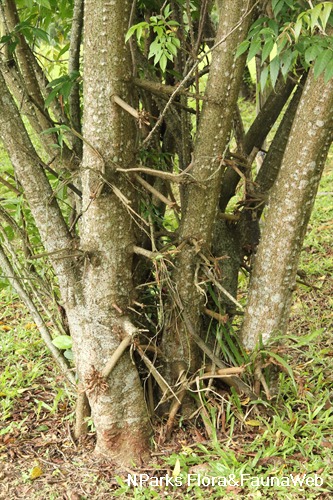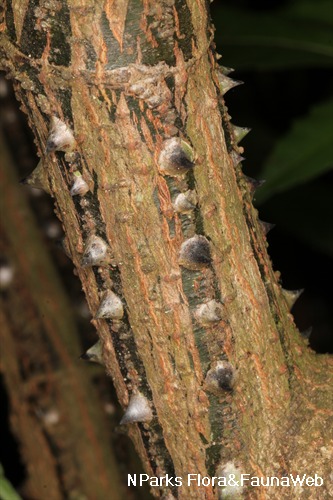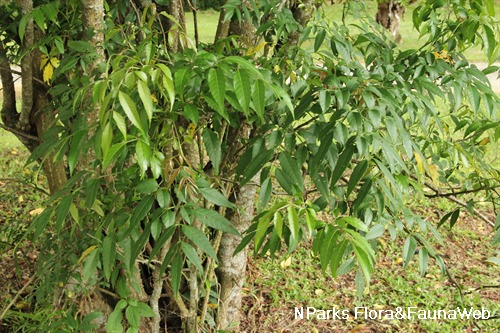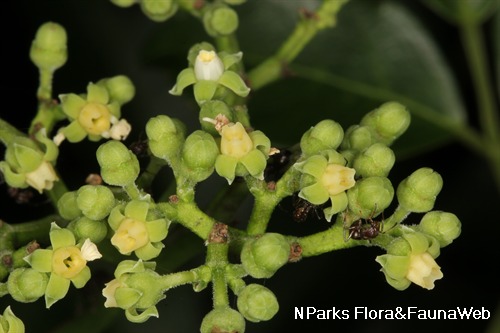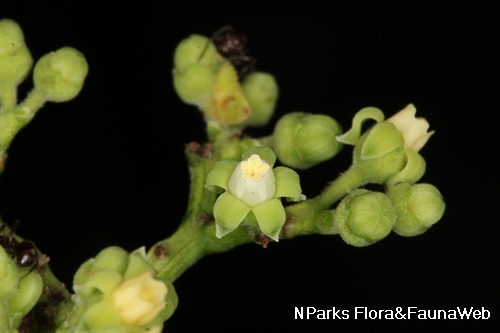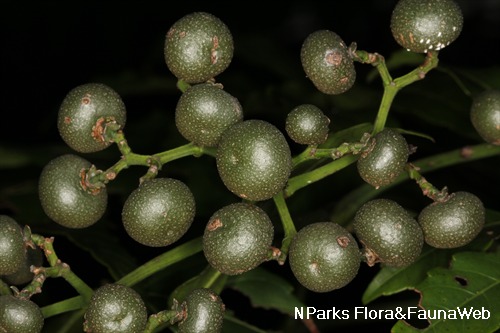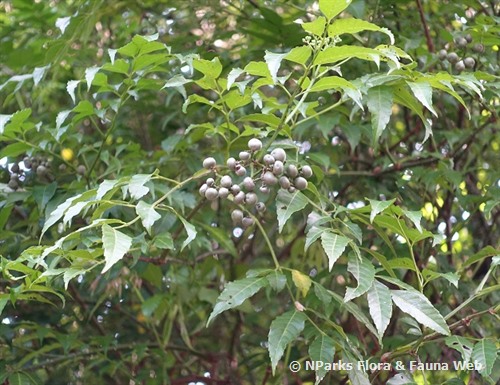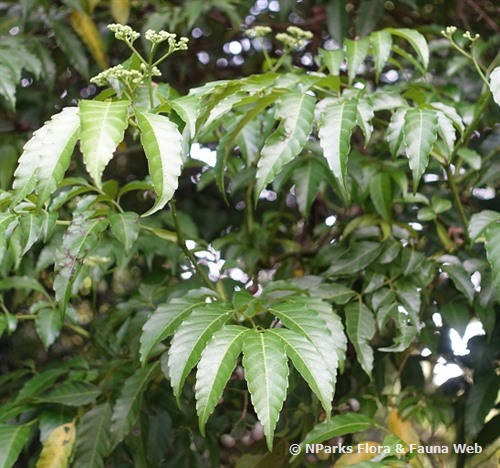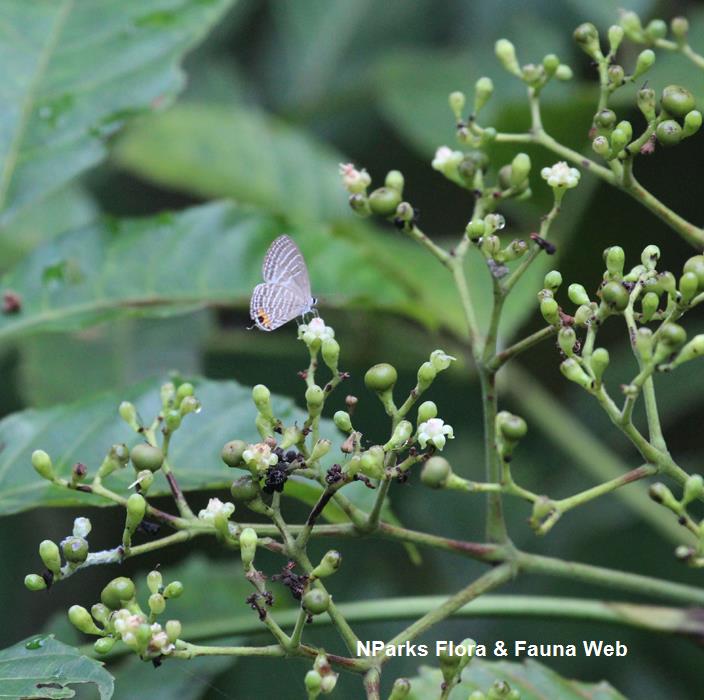
Back
Leea angulata Korth. ex Miq.
| Family Name: | Vitaceae |
| Common Name: | Memali, Thorny Tree-Vine, Mali Berduri, Mali-Mali, Toi |
Name
Classifications and Characteristics
| Plant Division | Angiosperms (Flowering Seed Plants) (Dicotyledon) |
|---|---|
| Plant Growth Form | Tree (Small (6m-15m)), Shrub |
| Lifespan (in Singapore) | Perennial |
| Mode of Nutrition | Autotrophic |
| Plant Shape | Irregular |
| Maximum Height | 15 m |
Biogeography
| Native Distribution | Nicobar Islands, Peninsular Thailand, Sumatra, Peninsular Malaysia, Singapore, the Philippines, north Borneo, Java, Lesser Sunda Islands, Celebes, and the Moluccas. |
|---|---|
| Native Habitat | Terrestrial (Primary Rainforest, Mountain, Secondary Rainforest, Coastal Forest, Riverine, Grassland / Savannah/ Scrubland) |
| Preferred Climate Zone | Tropical |
| Local Conservation Status | Native to Singapore (Critically Endangered (CR)) |
Description and Ethnobotany
| Growth Form | It is a prickly shrub or small tree up to 15 m tall. |
|---|---|
| Foliage | Its alternate, stalked, pinnate, bipinnate or tripinnate leaves are 15-60 cm long. |
| Flowers | Its branched flowering shoots are up to 5-10 cm wide. The flowers are greenish-white. |
| Fruit | Its bluish fruits are 8 mm wide, containing up to six seeds. |
| Habitat | It grows in sandy heath, secondary vegetation, and riverine forests, up to 1500 m altitude. |
| Associated Fauna | Its flowers are pollinated by insects and butterflies. Fruits are eaten by birds. |
| Cultivation | It can be propagated by seed or stem cutting. |
| Etymology | Latin Leea, a name for tropical small trees or shrubs named for James Lee (1715–1795), who was a nurseryman; Latin angulata, somewhat angled, probably referring to the angled prickles along the stem. |
Landscaping Features
| Landscaping | It is suitable for planting along streetscapes, parks and gardens, and also around edges of water as it tends to form prop roots in soft or wet soil. |
|---|---|
| Desirable Plant Features | Ornamental Foliage, Ornamental Fruits, Ornamental Form |
| Landscape Uses | General, Suitable for Roadsides, Parks & Gardens, Small Gardens, Coastal, Hedge / Screening, Riverine, Flowerbed / Border |
Fauna, Pollination and Dispersal
| Fauna Pollination Dispersal Associated Fauna | Bird-Attracting, Butterfly-Attracting |
|---|---|
| Pollination Method(s) | Biotic (Fauna) |
| Seed or Spore Dispersal | Biotic (Fauna) |
Plant Care and Propagation
| Light Preference | Full Sun, Semi-Shade |
|---|---|
| Water Preference | Lots of Water, Moderate Water |
| Plant Growth Rate | Moderate |
| Rootzone Tolerance | Moist Soils, Waterlogged Soils (Drains Site), Saline Soils / Salt Spray |
| Transplanting Tolerance | Good |
| Maintenance Requirements | Moderate |
| Propagation Method | Seed, Stem Cutting |
Foliar
| Foliage Retention | Evergreen |
|---|---|
| Mature Foliage Colour(s) | Green |
| Mature Foliage Texture(s) | Leathery |
| Foliar Type | Compound |
| Foliar Arrangement Along Stem | Alternate |
| Foliar Attachment to Stem | Petiolate |
| Foliar Shape(s) | Non-Palm Foliage |
| Foliar Venation | Pinnate / Net |
| Foliar Margin | Serrate / Toothed |
Floral (Angiosperm)
| Flower & Plant Sexuality | Bisexual Flowers |
| Flower Colour(s) | Green, White |
|---|---|
| Flower Grouping | Cluster / Inflorescence |
| Flower Location | Terminal |
| Flower Symmetry | Radial |
Fruit, Seed and Spore
| Mature Fruit Colour(s) | Green - Bluish Green |
|---|---|
| Fruit Classification | Simple Fruit |
| Fruit Type | Fleshy Fruit , Non-Accessory Fruit |
Image Repository
Others
| Master ID | 30061 |
|---|---|
| Species ID | 4370 |
| Flora Disclaimer | The information in this website has been compiled from reliable sources, such as reference works on medicinal plants. It is not a substitute for medical advice or treatment and NParks does not purport to provide any medical advice. Readers should always consult his/her physician before using or consuming a plant for medicinal purposes. |

